1. Introduction - Specifications
OCZ PC-4200EL Memory Review
 is
a well known company producing quality memory for almost all lines of PC users,
from amateurs to enthusiast overclockers. As a leading company in the memory
field, it recently introduced a product called “PC-4200EL” that
promised low latency times (CL2@400Mhz) along with the ability to run at
a high
speed of 533 MHz. Most PC-4000 and higher PC-4500 memory kits work only at
high latency times of 3-4-4-8. OCZ’s memory is of interest to users
who wish to reach maximum overclocking speeds while at the same time getting
the best
memory performance. Through our tests we will find out just how the memory
performs and what the maximum possible overclocking limit is?
is
a well known company producing quality memory for almost all lines of PC users,
from amateurs to enthusiast overclockers. As a leading company in the memory
field, it recently introduced a product called “PC-4200EL” that
promised low latency times (CL2@400Mhz) along with the ability to run at
a high
speed of 533 MHz. Most PC-4000 and higher PC-4500 memory kits work only at
high latency times of 3-4-4-8. OCZ’s memory is of interest to users
who wish to reach maximum overclocking speeds while at the same time getting
the best
memory performance. Through our tests we will find out just how the memory
performs and what the maximum possible overclocking limit is?
- Memory Description & Specs
 The
OCZ PC-4200EL comes as a dual channel kit and according to OCZ is hand tested
as a matched pair to ensure flawless performance on most motherboards. Each
memory module has a copper heat spreader and can handle up to 2.9V without voiding
the OCZ Lifetime Warranty! This is important, as it allows users to tweak their
systems without worrying about destroying their memory while enjoying maximum
performance!
The
OCZ PC-4200EL comes as a dual channel kit and according to OCZ is hand tested
as a matched pair to ensure flawless performance on most motherboards. Each
memory module has a copper heat spreader and can handle up to 2.9V without voiding
the OCZ Lifetime Warranty! This is important, as it allows users to tweak their
systems without worrying about destroying their memory while enjoying maximum
performance!
The OCZ PC-42000 comes with the "EL" suffix after the model name.
But what does “EL” mean? EL is the acronym from 'Enhanced Latency',
and is a special design procedure applied to each memory module allowing it
to run at tighter CAS latency timings than those specified under the current
JEDEC standards.
The memory specifications according to the OCZ website are:
- 466MHz DDR
- CL 2.5-4-4-7 (CAS-TRCD-TRP-TRAS)
- Available in 512MB and 1GB Dual Channel Kits
- Unbuffered
- Copper Heatspreader
- Lifetime Warranty
- 2.8 Volts
- 184 Pin DIMM
The retail kits are available in a 512MB Kit (PN- OCZ533512ELDC-K) and a 1GB
Kit (PN- OCZ5331024ELDC-K). We used the 512MB retail kit, which was obtained
at the price of ?220.00.

The retail kit also includes a case, stick-on badge, for those who want to
use it to show-off their OCZ advanced memory powered system.

2. Test Setup - PC settings
OCZ PC-4200EL Memory - Page 2
- Test Setup
- Defining Stable Memory
In order to make sure our memory was stable we used the Memtest86+ software.
At least 2 passes at extended mode should be error free before accepting the
corresponding FSB speed. After running the benchmarking software (AIDA32, Sisoft
Sandra 2004 & UT2004) under windows we ran two instances of Prime95 (Blend/Small
FFTs) while 3D Mark 2001SE was continuously looping, for at least six (6) hours,
to confirm the stability of the system. The 3D Mark 2001Se settings used for
all tests are shown in the following screenshots:
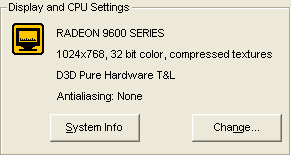
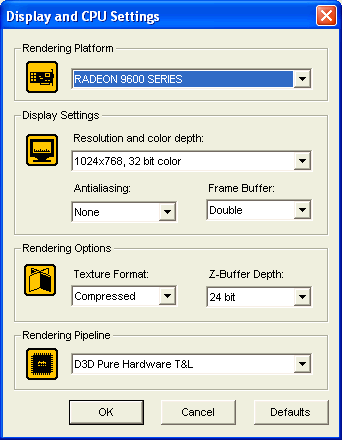
The figures displayed from the test results (AIDA32, Sisoft Sandra) are the
average after running each test three (3) times. Note that the Sisoft Sandra
results (Integer value and a Float value) were added and divided by 2 to give
us a single number for each test. For the UT2004 we used the Standard CTF Botmatch
Benchmark for UT2004demo v1.3 at only 1024x768 and we present the average FPS
results.
3. MSI Neo2 - FISR Testing procedure
OCZ PC-4200EL Memory - Page 3
- MSI Neo2-FISR general testing procedure
Each DDR memory module was installed in the 1st and 3rd bank respectively.
For optimum results we didn?t overclock the SVGA card, running at stock speeds
with official Catalyst v4.30 installed.
The following BIOS settings were used for all tests:
- Dynamic overclocking: Disable
- Performance Mode: Slow
- DRAM Frequency: 400Mhz
- Spread Spectrum: Disabled
- AGPI/PCI: 66.66/33.33
- VCore: 1.550V
- AGP: 1.60V
- DDR Voltage: 2.85V
- Burst Length: 4
 The
first step was to set the memory timings at 2.5-4-4-7 and 2-3-3-6. Unfortunaly
the MSI Neo2-FISR, despite our efforts, could not set the memory timings
to 2-3-3-6 but only to 2.5-3-3-6. The BIOS showed timings of 2-3-3-6 but
under windows we saw that the correct timings were 2.5-3-3-6.
The
first step was to set the memory timings at 2.5-4-4-7 and 2-3-3-6. Unfortunaly
the MSI Neo2-FISR, despite our efforts, could not set the memory timings
to 2-3-3-6 but only to 2.5-3-3-6. The BIOS showed timings of 2-3-3-6 but
under windows we saw that the correct timings were 2.5-3-3-6.
Also, no higher relaxed timings were possible (3-4-4-8). After checking other
hardware reviews, we believe the problem lies with the MSI motherboard?
After the initial tests at 200 MHz, we started pushing the system by raising
the FSB. We found the upper limit with the tight timings (2.5-3-3-6) at both
1:1 and 5:4 and the maximum speed with default timings (2.5-4-4-7) at both 1:1
and 5:4 (FSB:RAM).
PAT was not used for any test since the system could not boot at either speed
(again, possibly a specific M/B problem?). With the FSB 290 MHz (1:1) we raised
the DDR voltage up to 2.90V to reach maximum stability. Both Memtest86+ and
3D Mark2001SE did not report any problems but?Prime95 after running for one
hour stopped working, producing an error! This is why we selected the FSB 270
MHz as the maximum speed for this test. We decided to provide the FSB 272 MHz
results for evaluation proposes. It is possible that a different combination
of M/B and CPU cooler could produce higher (and better) results than even 272
MHz as various other testers have shown.
Summarizing, we tested the following FSB/Divider/Timings/DDR Voltage:
FSB |
Divider |
Memory
Timings
|
DDR
Voltage
|
CPU
Speed
|
Comment |
200 |
1:1 |
2.5-4-4-7 |
2.85V |
2.40 GHz |
|
200 |
1:1 |
2.5-3-3-6 |
2.40 GHz |
|
228 |
1:1 |
2.5-3-3-6 |
2.73 GHz |
(max FSB with tight timings for 1:1
stable) |
267 |
1:1 |
2.5-4-4-7 |
3.20 GHz |
|
270 |
1:1 |
2.5-4-4-7 |
3.24 GHz |
(max FSB with relaxed timing for 1:1
stable) |
272 |
1:1 |
2.5-4-4-7 |
3.26 GHz |
|
280 |
5:4 |
2.5-3-3-6 |
2.90V |
3.36 GHz |
(max FSB with tight timings for 5:4
not stable) |
290 |
5:4 |
2.5-4-4-7 |
2.85V |
3.48 GHz |
(max FSB with relaxed timings for 5:4
not stable) |
As you can see, with FSB 290 MHz (5:4) the CPU reaches the incredible 3.48
GHz. Of course the system was not stable enough to run 3D Mark2001Se
neither Prime95 at both FSB 290/280 MHz, however by using liquid cooling, it
could produce a stable system?:-)
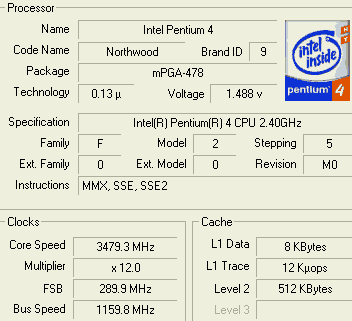
The system was rock solid at 1:1 at 270 MHz, while the CPU reached?3.240
GHz. That?s a 0.8 GHz overclocking gap!
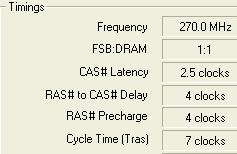
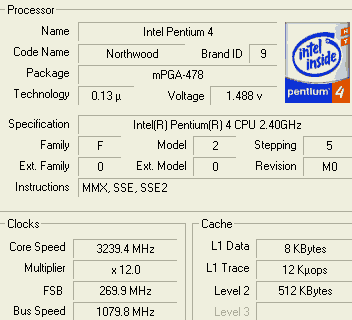
4. MSI Neo2 - FISR Test Results
OCZ PC-4200EL Memory - Page 4
- MSI Neo2-FISR Test Results
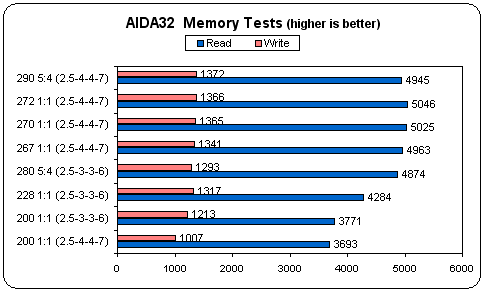
As we can see, the best read performance comes from FSB 272 MHz, while the
best write from FSB 290 MHz. The FSB 270 MHz is very close and should be used
for a stable system, while the tight timings (2.5-3-3-6) seem to offer significant
performance improvement over the relaxed (2.5-4-4-7) as was expected.
Let?s now look at the Sisoft Sandra results!
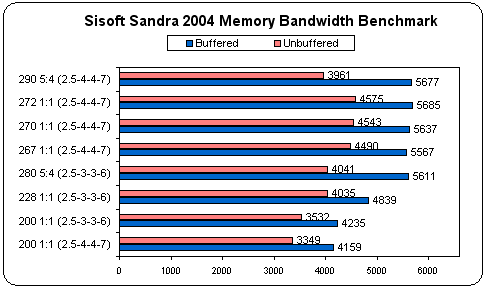
The higher the FSB goes, the higher the memory performance we get as the above
chart shows. The tight memory timings do impact upon memory performance, but
when running the memory at its designed (and above) speeds, you get the maximum
performance. The memory will work very well under 5:4 at both 280/290 MHz but
with lower Unbuffered results (as expected since Memory is underclocked?)
5. ASUS P4C800E Deluxe - Testing procedure
OCZ PC-4200EL Memory - Page 5
- ASUS P4C800E-Deluxe general testing procedure
After our disappointing results with the MSI Neo2-FISR we contacted OCZ, who
suggested that we should use a motherboard capable of reaching high FSB speeds,
like the ASUS P4C800E-Deluxe. Actually most PC4200/4400 work perfectly
only with ASUS and several other motherboards, so it is suggested to search
before buying memory that will not perform as you would expect…
Again each DDR memory module was placed in the 1 and 3 bank respectively. The
following BIOS settings were used for all tests:
- Performance Mode (PAT): Standard/Turbo
- DRAM Frequency: 400Mhz
- Spread Spectrum: Disabled
- AGPI/PCI: 66.66/33.33
- VCore: 1.550V
- AGP: 1.60V
- DDR Voltage: 2.85V
- Burst Length: 4
- VIA Raid: Disabled
This time we decided to take a different approach to our testing and tested
only four memory/timings as the following table shows:
Summarizing, we tested the following FSB/Divider/Timings/DDR Voltage:
FSB |
Divider |
Memory
Timings
|
DDR
Voltage
|
CPU
Speed
|
Comment |
201 |
1:1 |
2-3-3-6 |
2.85V |
2.412 GHz |
|
267 |
1:1 |
2.5-4-4-7 |
3.207 GHz |
|
272 |
1:1 |
2.5-4-4-7 |
3.265 GHz |
(max FSB with normal timings for 1:1 stable) |
279 |
1:1 |
2.5-4-4-7 |
3.35 GHz |
(max FSB with relaxed timings for 1:1 stable) |
As you can see the memory has no problem working at 2-3-3-6 at 201FSB with
PAT enabled (Turbo). Actually, we enabled PAT for all the above testing FSB
since it gave much better overall results. The maximum FSB we reached while
maintaining a 100% stable system was 272 with normal timings, while relaxing
timings (3-4-4-7), we reached the incredible 279 FSB. At that speed, the CPU
reached 3.35 GHz!
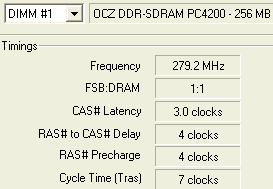
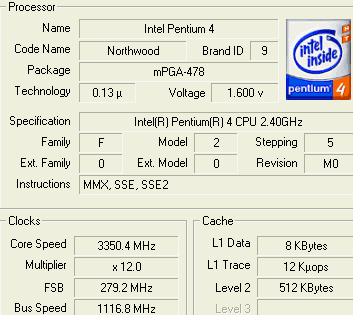
Note that the system was fairly stable at 282 FSB but Prime95 Small FFTs reported
errors, while the Blend test didn?t. Maybe with better cooling users can achieve
even higher FSB. Another problem is that the ASUS P4C800E-Deluxe allows only
up to 2.85V for DIMMs. There are several mods that can fix this problem, so
there is certainly room for higher speeds for experienced overclockers.
6. ASUS P4C800-E Deluxe Test Results
OCZ PC-4200EL Memory - Page 6
- ASUS P4C800-E Deluxe Tests
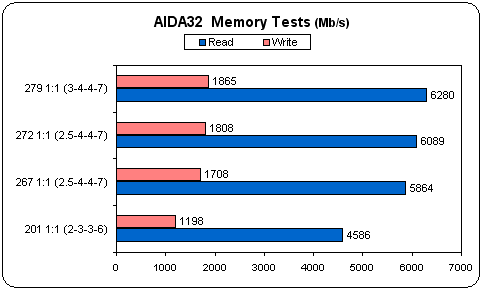
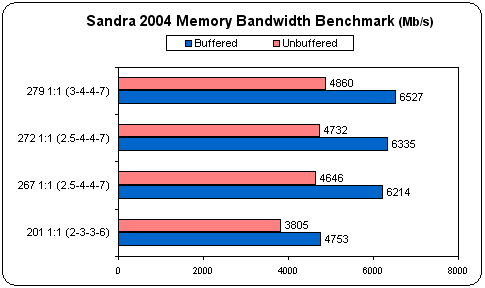
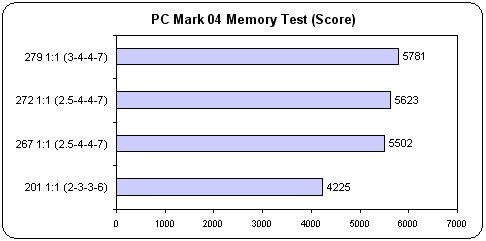
The memory bandwidth was very good (~6.5MB/s) as both AIDA32 and Sisoft Sandra
2004 showed. PC Mark 04 also showed clearly that at higher FSB we have higher
bandwidth. Let?s see whether the increased memory speeds affect 3D performance
or not...
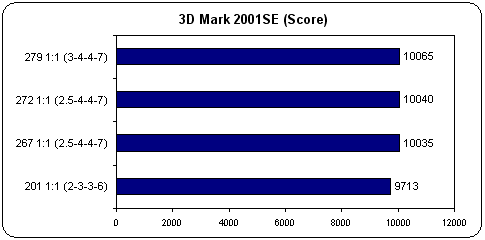
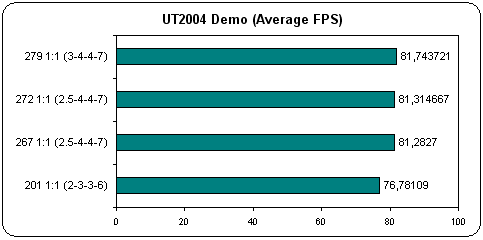
The 3D Mark 2001SE test didn?t show any affects from the overall FSB/RAM increments.
The difference between 267 and 279 FSB is only 20 marks, while the CPU difference
is 140 MHz. We knew that recent games were mainly affected by GPU performance
and not from the CPU/Memory combination and this shows up perfectly in the UT2004
demo results. The 267/272/279 MHz FSB speeds have almost the same FPS (Frame
Per Second). Buying a better SVGA card (ATI 9800XT for example) would have a
big impact on games performance.
7. Conclusion
OCZ PC-4200EL Memory - Page 7
- Conclusion
The OCZ PC-4200EL is referred as a ?Universal High-Speed Memory? according
to the official OCZ press release. It offers what it promises, memory speeds
up to DDR558+Mhz (depending the M/B and memory voltage) and lower memory timings
than any other PC4200/4300/4400 memory kits currently sold. The memory will
be useful for people who have a P4 2.4, 2.6 and even 2.8 GHz processor and wish
to overclock (1:1) their CPU to the maximum speed. P4 3.00, 3.2 and especially
3.4 GHz users might not find the memory useful since other OCZ products offer
lower cache latency (2-3-3-6) and good overclocking abilities as well.
Coming back to our tests, we saw that it is important to use the proper motherboard
in order to get the best results. The MSI Neo2-FISR was not a good choice for
testing since we couldn?t get CL2 at DDR400 and higher than 270 FSB speed (1:1).
The OCZ PC-4200EL memory showed its true performance with the ASUS P4C800E-Deluxe
and nearly gave 1 GHz overclocking on our P4 2.4C while the system was rock
solid even with air cooling. If the ASUS motherboard allowed voltages higher
than 2.85V for DDR, we are sure it could reach even 290 FSB (1:1) as several
other reports have shown. Possibly with 5:4 (FSB:RAM) setting the FSB could
break the magic 300Mhz barrier, but we wanted to test only the 1:1 synchronous
operation.
We hope in the near future to test the latest OCZ PC-4400EL and other high
speed memory from other vendors so we can have a clearer view regarding such
fast memory devices and what can be offered to both low/high end P4 users. Overall,
the OCZ PC-4200EL is a product we would highly recommended for all overclocker
enthusiasts!
The Good:
- Supports CL2 at DDR400
- Supports CL2.5 at DDR533
- Can go up to DDR558+ offering very good overclocking capabilities (1:1)
- DDR Voltage can raised up to ~3.0V without breaking warranty
- Very good performance at all speeds
The Bad:
- Works best with specific motherboards, so be careful before buying!
Like to be fixed:
- Maybe a lower price? ;-)